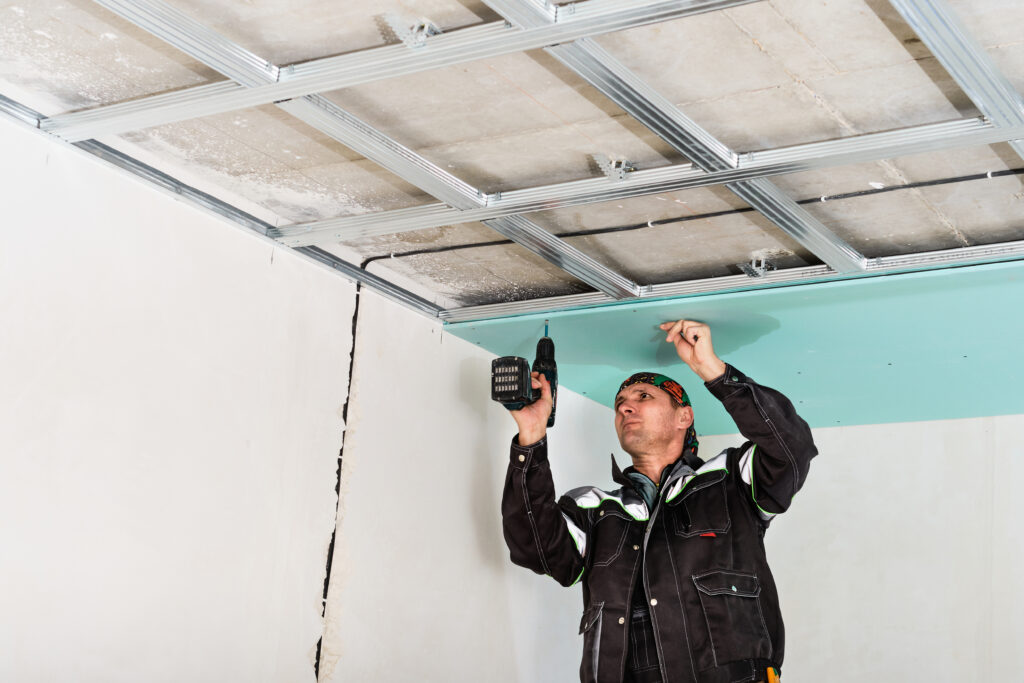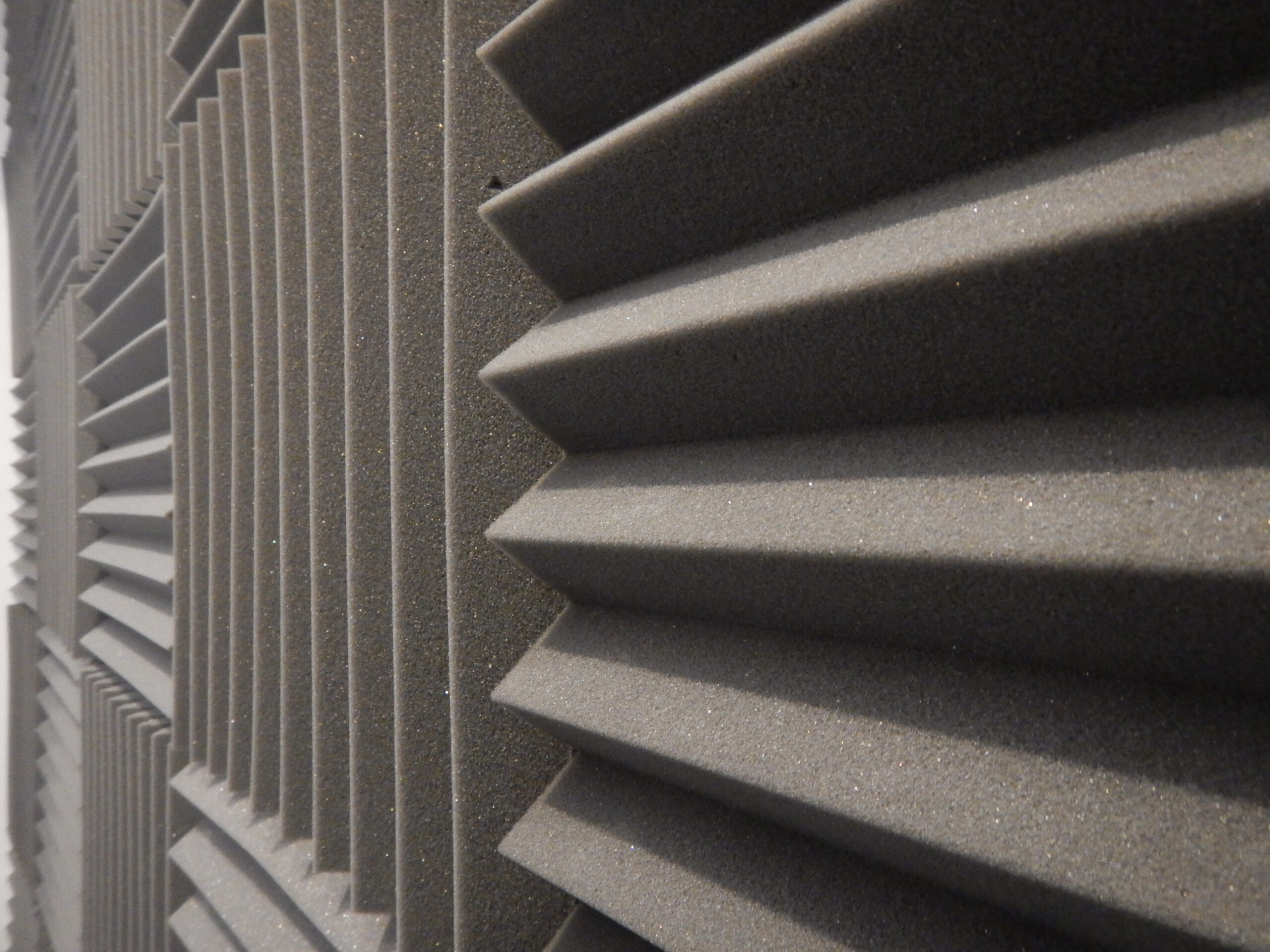Our well-being in the hectic world of today depends on finding a calm surroundings. Managing unwanted noise and transforming environments into quiet areas where we may work, relax, and live comfortably depends mostly on soundproof insulation.
This specialized insulation works by absorbing and blocking sound waves using specially designed materials and careful installation methods. The effectiveness of noise reduction depends on:
- Material density and composition
- Installation techniques
- Wall assembly design
- Quality of workmanship
To achieve the best acoustic comfort, it’s important to choose the right materials and use proper installation methods. A well-designed soundproofing system can reduce noise transmission by up to 80%, greatly improving sound isolation between spaces.
The benefits of soundproof insulation go beyond just reducing noise – it also enhances privacy, improves concentration, and leads to better sleep quality. Whether in homes, offices, or specialized facilities, the right combination of materials and installation techniques can turn ordinary spaces into balanced acoustic environments.
Types of Soundproof Insulation Materials
The market offers diverse soundproofing solutions, each designed to address specific acoustic challenges. Let’s explore mineral wool, a highly effective sound-dampening material that sets industry standards for noise reduction.
1. Mineral Wool
Mineral wool, also known as stone wool or rock wool, stands out as a premium choice for sound insulation. This versatile material consists of natural minerals melted at high temperatures and spun into dense, fibrous layers.
Key Properties:
- Density: 3.5 to 8 pounds per cubic foot
- Sound Absorption: NRC ratings up to 0.95-1.00
- Fire Resistance: Non-combustible with melting points above 2000°F
- Installation Flexibility: Available in batts, boards, and blankets
Sound Absorption Benefits:
The unique fiber structure of mineral wool creates millions of tiny air pockets that trap and dissipate sound waves. This characteristic makes it particularly effective at:
- Reducing airborne noise transmission
- Minimizing echo and reverberation
- Dampening low-frequency sounds
- Controlling sound transfer between rooms
For more detailed insights on effectively soundproofing a room, visit a comprehensive guide to noiseproofing.
Fire Safety Advantages:
Mineral wool’s fire-resistant properties provide additional safety benefits:
- Zero flame spread rating
- No toxic smoke emission
- Maintains structural integrity during fires
- Acts as a fire barrier in walls and ceilings
These advantages are highlighted in a comprehensive brochure about AFB acoustical fire batts that showcases the product’s effectiveness in various settings.
The material’s thermal stability ensures consistent performance across varying temperatures, making it ideal for:
- Home theater rooms
- Recording studios
- Multi-family housing
- Commercial buildings
- Industrial facilities
Mineral wool’s combination of sound absorption and fire resistance creates an exceptional insulation solution for spaces requiring premium acoustic treatment. The material’s durability and resistance to moisture, mold, and mildew contribute to its long-term effectiveness in various applications.
2. Fiberglass
Fiberglass insulation combines glass fibers with a binding agent to create a versatile soundproofing material. This cost-effective solution delivers a dual benefit of thermal regulation and noise reduction, making it a popular choice for both residential and commercial applications.
The unique structure of fiberglass creates millions of tiny air pockets that trap sound waves, reducing their transmission through walls, ceilings, and floors. With an STC rating ranging from 39 to 45, fiberglass effectively dampens mid to high-frequency sounds.
Key Features:
- Density Options: Available in different densities for varied soundproofing needs
- Installation Flexibility: Comes in batts, rolls, or loose-fill forms
- Moisture Resistance: Treated variants resist mold and mildew growth
- Cost-Effectiveness: Budget-friendly compared to specialized soundproofing materials
The installation method significantly impacts fiberglass’s soundproofing performance. Compressed installation reduces effectiveness, while proper spacing maximizes both thermal and acoustic benefits. For optimal results, fiberglass works best when combined with other sound-dampening techniques such as resilient channels or mass-loaded vinyl barriers.
3. Cotton Insulation (Quiet Batt®)
Cotton insulation stands out as an eco-conscious choice in soundproofing solutions, with Quiet Batt® leading the market. This innovative product achieves an impressive .95 NRC rating, absorbing 95% of sound energy that comes into contact with the material.
Key Features of Quiet Batt®:
- Made from recycled denim and cotton fibers
- Class-A fire rating
- Naturally resistant to mold and mildew
- Free from harmful chemicals and irritants
- Easy to handle and install without protective gear
The dense fiber structure of Quiet Batt® creates multiple air pockets that trap sound waves effectively. This unique composition makes it particularly effective for:
- Home theaters
- Music rooms
- Recording studios
- Office spaces
- Residential walls between bedrooms
The material’s natural properties allow it to maintain its shape and effectiveness throughout its lifetime, requiring minimal maintenance. Quiet Batt® also contributes to thermal insulation, providing an R-value of R-13 for standard walls and R-19 for ceiling applications.
4. Cellulose Insulation
Cellulose insulation stands out as an environmentally conscious choice for soundproofing solutions. Made from recycled paper products – primarily newspaper – this material transforms waste into an effective sound barrier. The manufacturing process involves treating the paper with fire-retardant chemicals, creating a safe and sustainable insulation option.
Key Benefits of Cellulose Insulation:
- Eco-Friendly Profile: 85% recycled content, low embodied energy, reduced landfill waste
- Sound Absorption Properties: dense fiber structure, STC ratings up to 44, fills gaps and voids effectively
The installation process involves either dry-blown or wet-spray application methods. Dry-blown cellulose settles into wall cavities, while wet-spray adheres directly to surfaces, creating a seamless sound barrier. This versatility makes cellulose insulation suitable for both new construction and retrofit projects.
The material’s density helps reduce sound transmission through walls and ceilings by dampening vibrations and absorbing acoustic energy. Its natural fiber composition creates millions of tiny air pockets that trap sound waves, preventing them from traveling between spaces.
5. Spray Foam Insulation
Spray foam insulation offers unique soundproofing capabilities through two distinct variations: open-cell and closed-cell foam. Each type presents different acoustic properties and performance levels.
Open-Cell Spray Foam:
- Density: ~0.5 pounds per cubic foot
- Softer, more flexible structure
- Superior sound absorption properties
- Creates effective air barriers
- Cost-effective option
Closed-Cell Spray Foam:
- Density: ~2 pounds per cubic foot
- Rigid structure with enhanced durability
- Creates solid sound barriers
- Higher R-value per inch
- Water-resistant properties
The choice between these two types depends on specific soundproofing needs. Open-cell foam excels at absorbing mid-range frequencies and works well for interior walls. Closed-cell foam creates a robust barrier against low-frequency sounds, making it ideal for exterior walls and harsh environments.
The application process requires professional installation to ensure proper expansion and coverage. When correctly installed, spray foam fills every crack and crevice, creating a seamless sound barrier that outperforms traditional insulation methods in terms of both acoustic and thermal performance. Additionally, it’s worth noting that spray foam insulation can also benefit your roof, enhancing energy efficiency and durability.

Performance Metrics for Evaluating Soundproof Insulation Effectiveness
Sound insulation effectiveness relies on two critical measurements: Sound Transmission Class (STC) and Noise Reduction Coefficient (NRC). These metrics provide quantifiable data to assess soundproofing materials and make informed decisions.
Sound Transmission Class (STC)
STC ratings measure a material’s ability to block airborne sound transmission between spaces. The rating system operates on a scale where:
- 25-30: Normal speech can be understood
- 30-35: Loud speech audible but not intelligible
- 50-60: Very loud sounds barely heard
- 60+: Superior soundproofing; most sounds blocked
A higher STC rating indicates better sound-blocking capabilities. For reference, a standard interior wall with single-layer drywall typically achieves an STC rating of 33.
Noise Reduction Coefficient (NRC)
NRC ratings measure sound absorption capabilities on a scale of 0 to 1:
- 0.00: Perfect reflection (no absorption)
- 1.00: Perfect absorption
The NRC rating represents the average absorption coefficients at frequencies:
- 250 Hz
- 500 Hz
- 1000 Hz
- 2000 Hz
A material with an NRC rating of 0.75 absorbs 75% of sound energy while reflecting 25%. This measurement proves particularly valuable when designing spaces requiring specific acoustic properties, such as:
- Recording studios
- Home theaters
- Conference rooms
- Music practice spaces
The combination of both STC and NRC ratings provides a comprehensive understanding of a material’s soundproofing capabilities. While STC measures sound blocking, NRC indicates sound absorption – two distinct but equally important aspects of acoustic control.
Installation Techniques That Can Enhance Soundproofing Results Further
Professional soundproofing installations combine multiple techniques to create a robust barrier against noise transmission. The integration of double-layer drywall with damping compounds creates a dense, sound-resistant barrier that significantly reduces noise transfer between spaces.
Double-Layer Drywall Installation
- First layer acts as the primary sound barrier
- Second layer, combined with damping compounds like Green Glue, converts sound energy into heat
- Staggered seams between layers prevent sound leakage
- Minimum 5/8-inch thickness recommended for each layer
Resilient Channels and Clips
- Create an air gap between the wall structure and drywall
- Break the direct path of sound vibrations
- Reduce impact noise transmission
- Support weight distribution across the wall surface
The combination of these methods creates a sophisticated sound isolation system:
- Sound Wave Disruption: Resilient channels prevent direct contact between drywall and studs
- Vibration Absorption: Damping compounds between drywall layers absorb and dissipate sound energy
- Mass Enhancement: Double-layer construction increases the total mass, improving sound blocking
- Decoupling Effect: Clips and channels create a floating wall system that minimizes sound transfer
These installation techniques work synergistically to achieve superior soundproofing results, with potential noise reduction improvements of up to 20 STC points compared to standard single-layer construction methods.
Considering Specific Applications When Choosing Suitable Soundproof Insulation Solutions
Selecting the right soundproof insulation requires careful consideration of the specific environment and intended use. Different spaces demand varying levels of sound control, making it essential to tailor solutions to each unique situation.
1. Residential Use Cases
The application of soundproof insulation in homes serves multiple purposes:
Interior Wall Solutions
Bedroom privacy enhancement: Strategic insulation placement between bedroom walls creates peaceful sleeping environments
Home office productivity: Sound-dampening materials enable focused work spaces, particularly valuable for remote workers
Entertainment room isolation: Media rooms benefit from specialized insulation to contain sound systems and prevent noise leakage
External Noise Management
Urban environment protection: Homes near busy streets require robust insulation to block traffic noise
Aircraft noise reduction: Properties in flight paths need specialized solutions with higher STC ratings
Weather-related sound control: Protection against rain, wind, and storm sounds through roof and wall insulation
Multi-Family Living Spaces
Between-floor noise reduction: Footstep impact sound control through specialized floor insulation systems
Shared wall soundproofing: Enhanced privacy between adjoining units using double-wall construction techniques
HVAC and plumbing noise management: Strategic insulation placement around mechanical systems
Specialized Areas
Music practice rooms: Creating dedicated spaces for musical instruments without disturbing family members
Children’s play areas: Containing active play sounds within specific zones of the house
Utility room isolation: Minimizing noise from washers, dryers, and mechanical equipment
Property Value Benefits
Market differentiation: Enhanced soundproofing as a valuable selling point
Energy efficiency bonus: Dual benefits of sound and thermal insulation
Long-term investment: Increased property appeal through improved acoustic comfort
The residential application of soundproof insulation transforms living spaces into sanctuaries of peace and privacy. Each room presents unique acoustic challenges, requiring specific solutions tailored to its function and location within the home. The selection of appropriate materials and installation methods directly impacts the daily comfort and satisfaction of occupants.
2. Commercial Applications: Creating Quieter Work Environments
Commercial spaces have specific sound-related challenges that can affect productivity and employee well-being. To address these issues, sound control measures become crucial in various areas:
Open Office Layouts
- Partition walls with high STC ratings reduce cross-talk between departments
- Ceiling treatments absorb overhead noise from HVAC systems
- Floor-to-ceiling sound barriers create private meeting zones
Conference Rooms
- Double-layer drywall with specialized insulation prevents confidential discussions from being overheard
- Strategic placement of absorptive materials reduces echo and reverberation
- Sound-dampening door seals maintain acoustic integrity
Retail Environments
- Sound absorption panels regulate music and conversation levels
- Insulated walls between stores prevent noise transfer in shopping centers
- Acoustic ceiling tiles manage ambient noise in high-traffic areas
Healthcare Facilities
- Medical office privacy requirements demand superior soundproofing
- Patient rooms benefit from specialized wall assemblies
- Treatment areas require focused sound control for equipment noise
Hotels and Hospitality
- Guest room separation demands high-performance insulation systems
- Mechanical room isolation protects guest comfort
- Entertainment venues require customized acoustic solutions
The commercial sector often needs professional-grade soundproofing solutions that go beyond residential standards. Building codes and business requirements usually specify certain STC ratings for different spaces. Achieving the desired acoustic performance levels in commercial soundproofing depends on thorough planning and precise installation methods.
3. Specialized Uses In Studios/Recording Spaces
Recording studios require exceptional acoustic accuracy – a need that distinguishes them from typical residential or commercial soundproofing requirements. Professional studios use advanced soundproof insulation systems to create perfect recording spaces.
Critical Components for Studio Soundproofing:
- Double-Wall Construction: Separate wall structures with air gaps, independent floor and ceiling assemblies, and zero physical contact between walls to prevent sound transfer.
- Multi-Layer Insulation Strategy: Dense mineral wool in wall cavities, additional mass-loaded vinyl barriers, and specialized acoustic panels for fine-tuning.
Technical Considerations:
- Sound reflection control through strategic material placement
- Bass trap installation in room corners
- Precise calculations for room modes and standing waves
- Custom-designed ventilation systems to maintain silence
Studio-Specific Requirements:
- Control Rooms: Critical listening environments with balanced frequency response and minimal external noise interference.
- Live Rooms: Controlled reverberation times, variable acoustic treatments, and isolated electrical systems.
- Vocal Booths: Dead space creation, complete external noise elimination, and specialized absorption materials.
Professional studios often achieve STC ratings above 65, creating environments where even the subtlest audio nuances can be captured. These spaces use combinations of different insulation materials, each serving specific frequency ranges and acoustic purposes. The investment in proper studio soundproofing directly impacts the quality of recorded material and the studio’s professional reputation.

Conclusion: Making An Informed Choice About Your Space’s Acoustics
Selecting the right soundproof insulation combination transforms any space into an acoustically optimized environment. The key lies in:
- Material Selection: Match specific materials to your unique requirements, whether it’s mineral wool for fire resistance or cotton insulation for maximum sound absorption
- Professional Installation: Expert installation techniques ensure maximum effectiveness of your chosen materials
- Performance Metrics: Understanding STC and NRC ratings guides informed decision-making
- Space-Specific Solutions: Different environments demand tailored approaches – from residential privacy to professional studio standards
A thoughtful combination of appropriate materials and precise installation techniques creates the perfect balance of sound control and acoustic performance. This investment in proper soundproofing delivers long-lasting benefits, enhancing both comfort and functionality in any space.

